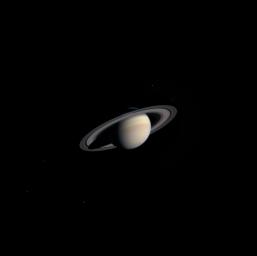
|
Looming Saturn
- Click the image above for a larger view
- Full-Res JPEG (1016 x 1011) (21.5 kB)
- Full-Res TIFF (1016 x 1011) (409.2 kB)
Caption:
December 5, 2003
A cold, dusky Saturn looms in the distance in this striking, natural color view of the ringed planet and five of its icy satellites. This image was composed from exposures taken by Cassini's narrow angle camera on Nov. 9, 2003, from a distance of 111.4 million kilometers (69.2 million miles). That is about three-fourths the distance of Earth from the Sun and 235 days from reaching Saturn. The smallest features visible here are about 668 kilometers (415 miles) across - a marked improvement over the last Cassini Saturn image released on Nov. 1, 2002. New features such as intricate cloud patterns and small moons near the rings should become visible over the next several months as the spacecraft speeds toward its destination.
Some details within Saturn's massive ring system are already visible. Structure is evident in the B ring, the middle and brightest of Saturn's three main rings. The 4,800 kilometer (2,980 mile)-wide Cassini Division is the distinctive dark, central band that separates the outermost A ring from the brighter B ring. Interestingly, the outer edge of the B ring is maintained by a strong gravitational resonance with the moon Mimas, also visible in this image. The 325-kilometer (200 -mile) wide Encke gap in the A ring, near the outer edge of the ring system, is also visible, as is the fainter C ring, interior to the B ring.
Saturn's multi-banded, multi-hued atmosphere is also apparent at this distance. In the southern polar region, a dusky haze is visible, grayer than the light-brown at middle latitudes. Most of Saturn's northern hemisphere is in shadow of the rings, with the exception of a small sliver visible on the limb. Five Saturnian satellites can also be seen in this image. The brightness of these bodies has been increased three- to five-fold to enhance visibility. The satellites are, on the left, from brightest to faintest, Rhea, Dione, and Enceladus, and on the right, from brightest to faintest, Tethys and Mimas.
Cassini will enter Saturn orbit on July 1, 2004.
Background Info:
For more information, see the Cassini Project home page at http://saturn.jpl.nasa.gov and the Cassini imaging team home page, http://ciclops.org . The imaging team is based at the Space Science Institute, Boulder, Colo.
The Cassini-Huygens mission is a cooperative project of NASA, the European Space Agency and the Italian Space Agency. The Jet Propulsion Laboratory, a division of the California Institute of Technology in Pasadena, manages the Cassini mission for NASA's Office of Space Science, Washington, D.C.
Cataloging Keywords:
| Name | Value | Additional Values |
|---|---|---|
| Target | Saturn | B Ring, Cassini Division, Dione, Enceladus, Encke Gap, Mimas, Rhea, Saturn Rings, Tethys |
| System | Saturn | |
| Target Type | Planet | Gap, Ring, Satellite |
| Mission | Cassini-Huygens | |
| Instrument Host | Cassini Orbiter | |
| Host Type | Orbiter | |
| Instrument | Imaging Science Subsystem (ISS) | |
| Detector | Narrow Angle Camera | |
| Extra Keywords | Atmosphere, Color, Haze, Shadow, Visual | |
| Acquisition Date | ||
| Release Date | 2003-12-05 | |
| Date in Caption | 2002-11-01 | 2003-11-09, 2003-12-05, 2004-07-01 |
| Image Credit | NASA/JPL/Space Science Institute | |
| Source | photojournal.jpl.nasa.gov/catalog/PIA04913 | |
| Identifier | PIA04913 | |
